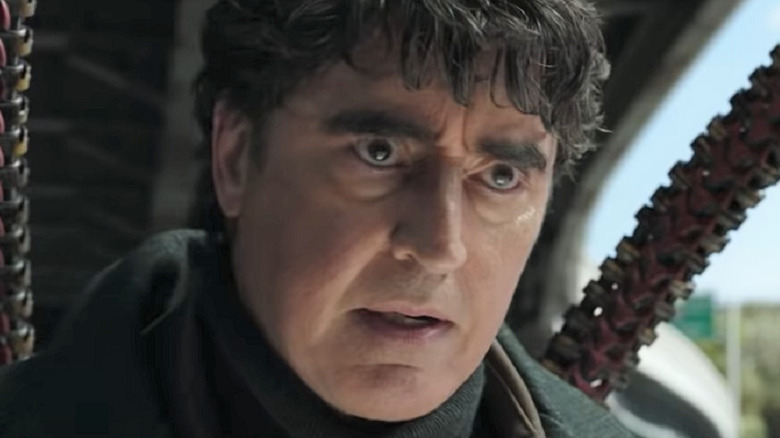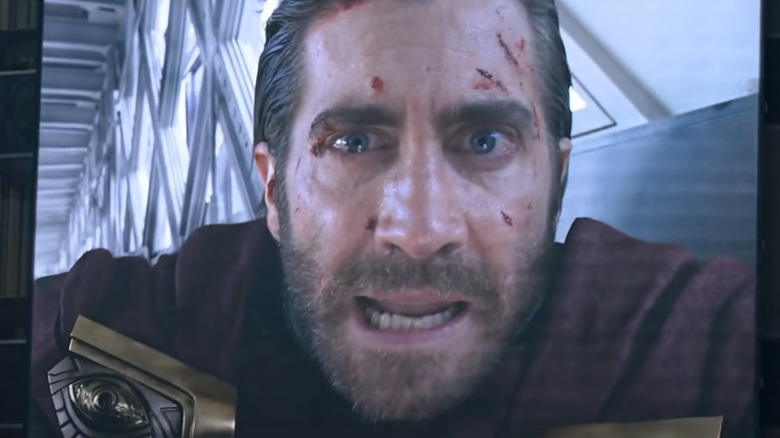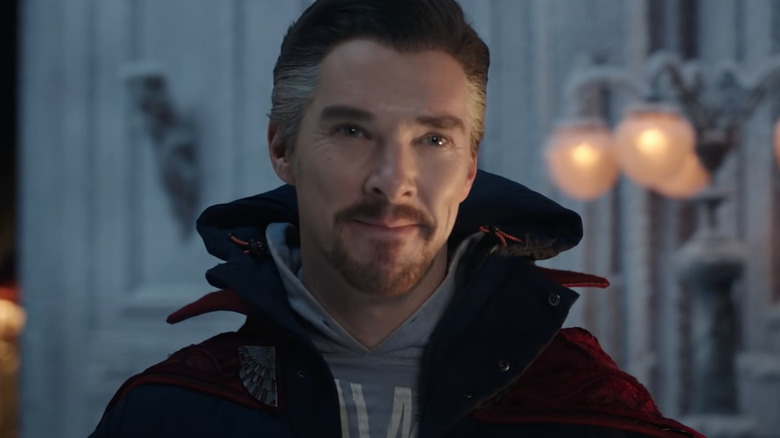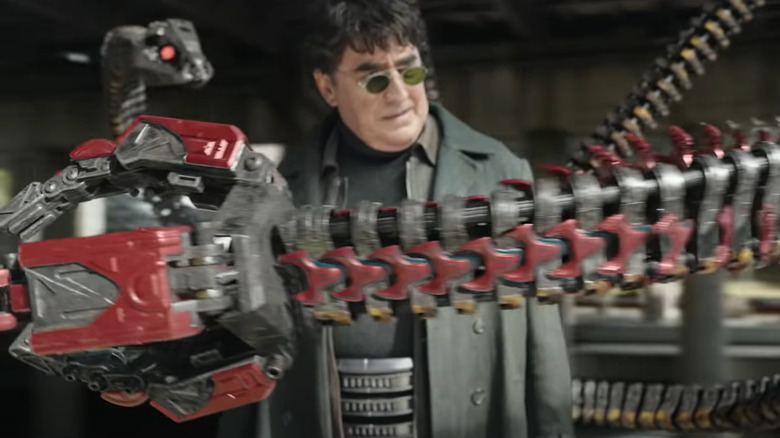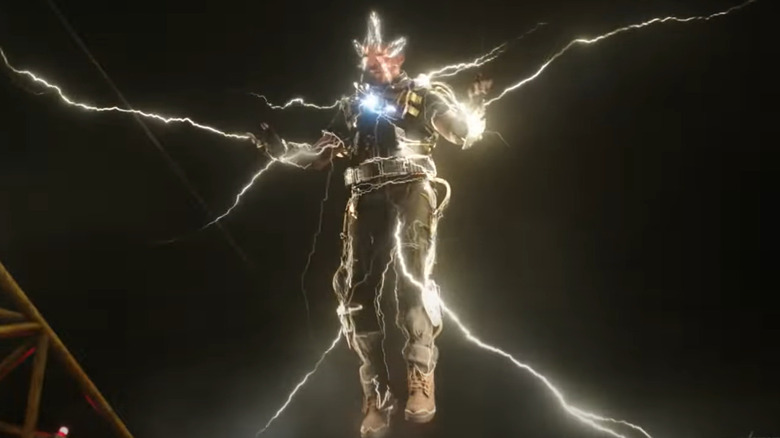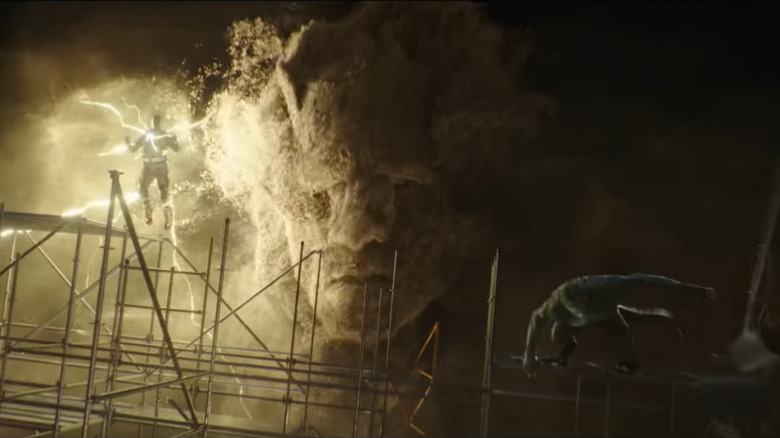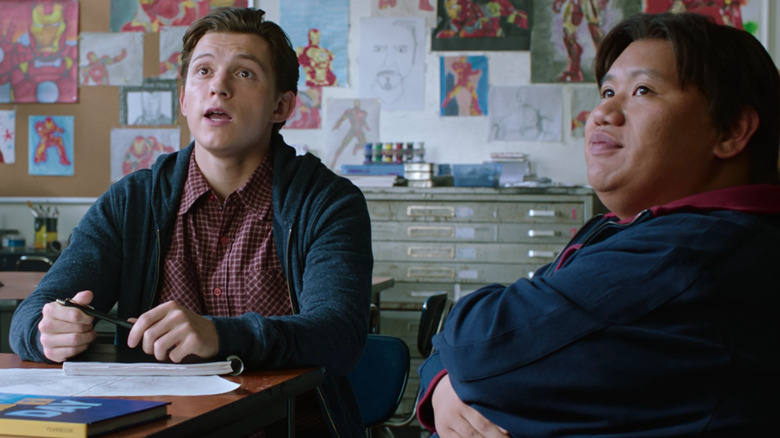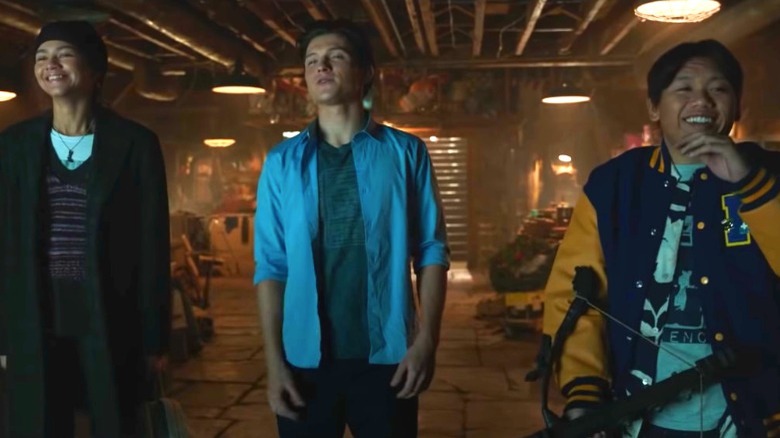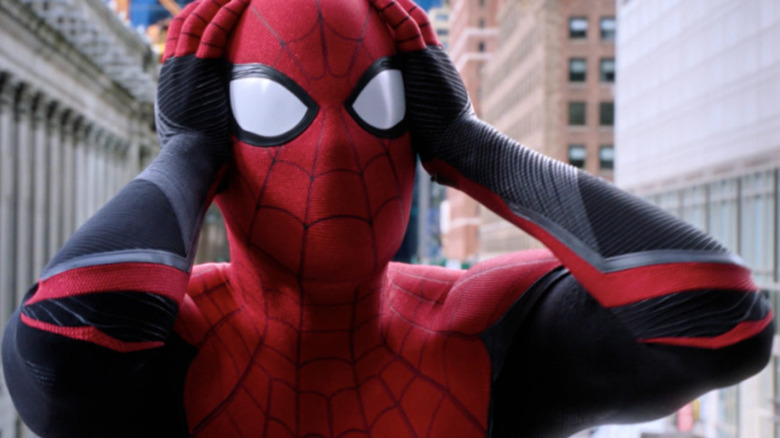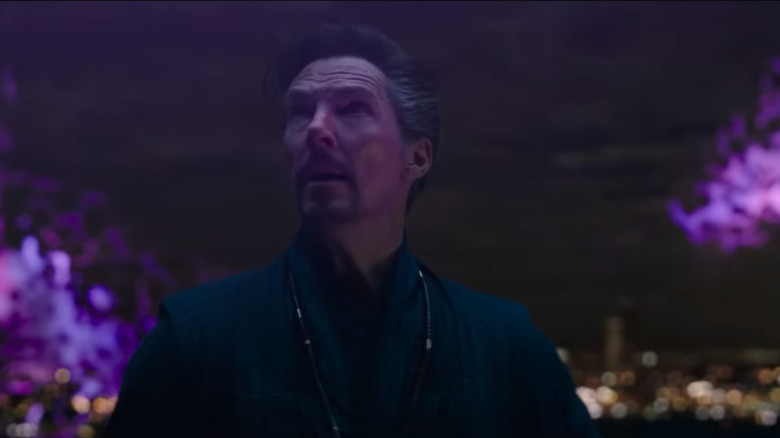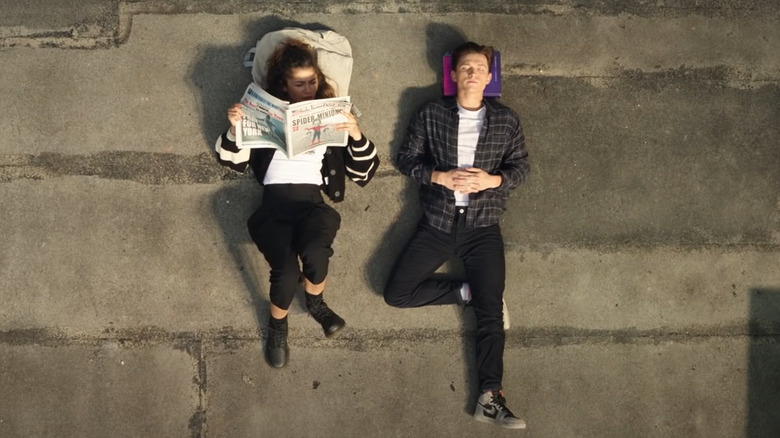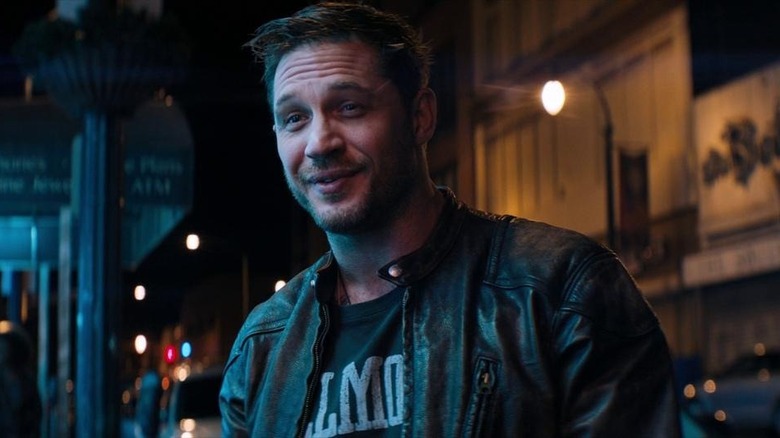Confusing Moments In Spider-Man: No Way Home Explained
In the months leading up to its release, "Spider-Man: No Way Home" was one of the most anticipated films in MCU history. And boy, did it deliver on the goods. It's got magic, multiverses, and a whole host of baddies for Peter Parker to fight. On top of that, it has more than a handful of surprise appearances that made audiences around the world completely flip out.
In other words, there's a lot to process here. And sitting in the theater and being flooded with stunning visuals, breathtaking performances, and more nostalgia than the human heart is meant to handle probably didn't leave you with enough time to consider the deeper implications of everything happening on-screen. With so many heroes and villains battling for the fate of the multiverse, "No Way Home" created more than a few lingering questions. But worry not — here are the most confusing moments in "Spider-Man: No Way Home" explained.
Warning — major spoilers below.
How did Mysterio fake his murder?
"No Way Home" opens at exactly the point where "Far From Home" ended. A breaking news report from the Daily Bugle's incorrigible J. Jonah Jameson reveals two key pieces of information to the world: Spider-Man is Peter Parker, and he killed Mysterio. It's no wonder, and almost no surprise, that Mysterio was able to capture footage of Peter to be released after his death, but how exactly did the villain manage to convince the world that Spider-Man had murdered him and unleashed a drone army?
There were some major flaws in Mysterio's posthumous plot right from the start. For one thing, anyone in London during Mysterio's attack would've been able to see that Spider-Man was battling all the drones that attacked the city. Even though Mysterio managed to fake Peter's voice ordering the drones to strike, it's hard to believe that not a single camera in London captured some footage of the webslinger's good deeds.
Because all Mysterio's framing plot could rely on was some faked audio and footage of himself merely saying that Spider-Man was about to attack him, it all fell apart pretty quickly. Peter crawled his way out of any legal troubles with ease, but there's always someone who will fall for a conspiracy theory. Most of the world might be convinced of Spider-Man's innocence, but Jameson and the Bugle's fans are still holding out for solid proof of Spider-Man's misdeeds.
Why isn't Doctor Strange the Sorcerer Supreme?
Peter being outed as Spider-Man causes problems for just about everyone in his life. To him, it suddenly looks like the future he envisioned for himself — happily studying at college alongside his best friend and girlfriend — will never become a reality. On top of that, he and Aunt May have to shelter in Happy's apartment to hide from any Spider-Man conspiracy theorists still out there. Reeling from all the chaos, Peter thinks of the one person who might be able to magically make his troubles go away.
When Peter shows up at the Sanctum Santorum, however, Doctor Strange informs him that he's no longer the Sorcerer Supreme. Because the role is so important, it needed to be filled immediately after the Snap turned Strange to dust in the wind. The only person who could properly fill Doctor Strange's shoes was, of course, Wong, who in reality has been working with the magical arts for longer than Strange himself. While we might've expected Strange to take his position back when he un-Blipped, that would hardly be fair to Wong. Besides, Strange seems perfectly content to focus on his own pursuits, and Wong must be at least a little relieved to have some say in what hijinks Strange gets up to — not that Wong's influence was able to prevent Strange from breaking open the multiverse while trying to help Peter.
How did Peter control Doc Ock's arms?
The first villain to burst onto the scene is none other than Doc Ock. When he arrives, he's clearly going for mass destruction, and he starts off poised to give the MCU's Spider-Man just as much of a run for his money as he did Raimi's Spider-Man back in 2004. Luckily, today's Peter has access to some tech that Doc Ock's previous foe did not. When a giant metal tentacle tears into Peter's Stark suit, the severed nanobots fuse into Ock's arms and hand over their control to Peter.
It's great that Peter finally has the upper hand in his fight, but how were those nanobots able to interface with Doc Ock's technology? We have to hand this one to Tony Stark, who's always able to think one or 10 steps ahead of any problem he might encounter. This isn't the first time Stark's tech has been shown to be adaptable and capable of more or less thinking for itself, and clearly, Peter's nanobot-powered suit was designed to change depending on the problems he encounters.
"No Way Home" gives another look at the nanobots' pseudo-intelligence later in the film when they slither off a pacified Doc Ock's arms and reform into a cool looking spider logo on Peter's suit. Without a doubt, Peter owes this lucky break to Tony, and now that EDITH is gone, this might've been the last time his mentor's technology is able to get him out of a jam.
What happened to Electro's body?
Anyone who didn't spend the months leading up to "No Way Home" on an internet sabbatical knew that Jamie Foxx was returning to play Electro. After trailers and stills showed a very different-looking villain than the one featured in "The Amazing Spider-Man 2," everyone began wondering what universe this Electro really belonged to. However, when Electro first arrives in the film, he looks like his old blue self for just a flash before yellow electricity floods his body, and he changes back into a more Jamie Foxx-looking version of the character.
There are a few different things going on with Electro's transformation. Outside the world of the movies, Electro's design in "The Amazing Spider-Man 2" wasn't particularly popular, so a reskin was never going to be out of the question. "No Way Home" could've left the change up to the magic of the multiverse, but the film actually takes a bigger step towards a genuine explanation.
Since he first gained his powers, Electro's body has been entirely composed of the electrical energy in his world. He says that the electricity in the MCU feels different — and more powerful — than that of his home universe. It doesn't take a scientist to imagine that drawing on a different form of energy to create his body could give Electro a different look. Plus, no one is going to complain about getting to see Foxx's actual face during pivotal moments in the story.
How are Spidey's villains still alive?
So ... how are all these bad guys alive? This was one of the biggest questions leading up to the release of "No Way Home," and the film doesn't come right out with a solid answer for it. Each of Spidey's multiversal villains seem to have been pulled into the MCU from a point very near their death in their own universes. Doc Ock and Sandman remember the death of Norman Osborn, and Electro can recall the Lizard's story, but none of the villains are aware of their own fate. Electro gives the clearest answer, as he states that the last thing he can remember is Spider-Man using an overloaded power grid against him in battle. From that, it seems safe to assume that all the villains were pulled from the third act of their respective stories.
The presence of some other important figures from previous universes raises even more questions. Both multiversal Spider-Men explicitly arrive from some point in time after they were last seen on the big screen. Obviously, that's great for the audience, and it gives us a deeper sense of closure with the characters, but "No Way Home" doesn't explain why there's such a discrepancy between the heroes and the villains. This one will have to be chalked up to the magic of the multiverse.
Is Ned magic now?
One of the best parts about "No Way Home" is getting to see Peter's friends truly join in on all the action. Ned and MJ play key roles in the film, and without their help, there's no way that Peter would've survived to see a brand new day. Ned has been Peter's "man in the chair" since "Homecoming," but he takes a big step up in this adventure.
When Ned and MJ first arrive at the Sanctum Santorum, he mentions a rumor in his family that some of their ancestors had magical abilities. Later, Ned ends up with Doctor Strange's sling ring, and sure enough, he's able to use it to open multiple portals throughout the film. Ned is astounded by his new abilities, but his grandmother — who presumably could have some deeper insight into the family's magical past — hardly blinks an eye.
We already know that magical abilities aren't necessarily linked to lineage. Unless it's later revealed that Doctor Strange has some magic in his family's past, he became a sorcerer through nothing more mysterious than rigorous study and hard work. It's possible that some latent ability in Ned's genetics allowed him to focus some energy through a sling ring with ease, but without further instruction, it's unlikely that he'll become a true sorcerer. Of course, we have to wonder, does Ned even remember using magic now?
What universe are we in anyway?
For the most part, we've all assumed that the MCU takes place in roughly the same universe as the Marvel comics. Mysterio even gave a wink in that direction in "Far From Home" when he referred to this universe as "Earth-616," which is the Earth of the comics. The MCU films have naturally strayed from the source material at times, but no one could be sure that meant the two mediums belonged to separate universes entirely.
"No Way Home" definitively places the MCU somewhere other than the Earth-616 of the comic books. The signs are subtle but apparent to any true believers. The first hint comes when Aunt May gives Peter the "with great power" speech. Up until now, we could've assumed Peter got this speech off-screen from Uncle Ben, though the movies have never been clear about how Uncle Ben died. Now, Ben and May have switched roles. She's become the motivation, and guilt, that drives Spider-Man to become an even better hero.
The implied change in Spider-Man's "origin" is enough to let us know that this isn't the same world that was first explored in "Amazing Fantasy #15," but there's another small detail that makes things clearer later in the film. MJ reminds us that her name isn't Mary Jane but Michelle Jones. Especially with a Mary Jane-loving Peter Parker present on-screen, MJ's name is a concrete detail that shifts "No Way Home" away from the Earth-616 of the comics.
Did MCU Peter change all the other universe's timelines?
When Spider-Man villains from alternate universes start arriving in the MCU, Peter is determined to help Doctor Strange capture them and return them to their own worlds. That all changes when Peter discovers that almost all the villains he's captured died in their universes. Knowing that returning them home means sending them to their imminent deaths, Peter resolves to find a way to save them all.
The simple solution for saving the villains is to "cure" them of their various abilities. After all, if Spider-Man's foes aren't superpowered, they won't need to fight the hero to the death. It takes some multiversal assistance — and some serious sacrifice — for Peter to find a cure for each of the six baddies he's up against. Ultimately, he's able to de-power everyone before repairing the cracks in the universe and sending them all home. How does that impact the original universe of each villain?
"No Way Home" doesn't show what happens in the Raimi-verse and Webb-verse when everyone returns, but the changes are undoubtedly huge. No one would remember their time in the MCU, but all the villains would be returned to good guy status — or at least neutral guy status — well before they died. Because Harry Osborn didn't need to seek revenge for his father's death, is he still alive in the Raimi-verse? Without the final battle against Electro taking place, is Gwen Stacy alive in the Webb-verse? All that could be on the table now, but we'll have to wait for future announcements to know for sure.
Who did Doctor Strange see coming through the multiverse?
At the climax of "No Way Home," the multiverse is collapsing, and Doctor Strange is doing everything in his power to prevent all of reality from being pulled into the confines of the MCU. Clearly, whatever is coming through from alternate universes would be immensely destructive, but Strange plays coy about the specifics of the danger. "They are coming," he tells Peter, but he doesn't bother to explain who "they" are.
Two possibilities seem most likely here. First, Marvel's "What If?" on Disney+ has already shown that there's no shortage of dangerous characters out in the multiverse. Strange could've been referring to more Spider-Man villains — it definitely looks like Kraven and Rhino are on their way — or simply the evil alternates of the world's mightiest heroes. On the other hand, "Eternals" recently introduced a whole slew of new dangers into the MCU. In Strange's struggle against the multiverse, mysterious glowing figures are only briefly shown peeking through the cracks of reality, but the visuals had a striking resemblance to some of the Celestials we've already seen. Considering how dangerous a single Celestial can be, an army of them would be more than enough to make Strange sweat bullets. Either way, it seems very likely that "The Multiverse of Madness" will give us further hints.
Why didn't Peter tell MJ and Ned the truth?
The ending of "No Way Home" erases Peter Parker from the world. Doctor Strange's multiverse-saving spell makes everyone in the universe forget who Peter Parker is. Our hero tearfully promises his friends that he'll come find them before the slate gets wiped clean, but when he has the opportunity to speak to them, Peter doesn't reveal the truth.
Peter had a full speech prepared for his friends, so we know that he really intended on trying to convince them of everything that they'd forgotten. His turning point seems to come when he sees a bandaged gash on MJ's head. Peter knows that she got hurt because of his Spider-Man activities, and in an effort to protect both her and Ned, he decides to keep the truth to himself.
The motivation here makes perfect sense for the version of Peter Parker that the MCU has been building for years, but it's also pitch-perfect for the comic book character fans have come to love over more than 50 years. Spider-Man has always been willing to sacrifice for the greater good, and that often means giving up the things that would make him the happiest. Of course, we all hope that this doesn't mean Ned and MJ are finished in the MCU, but for now, Peter is bravely going it alone.
What's the deal with Venom?
"Venom: Let There Be Carnage" sent shockwaves through the nerd world with its end-credits scene. Eddie Brock and Venom were transported into the MCU just in time to see Peter Parker's secret identity revealed on the news by Mysterio and J. Jonah Jameson. We all wondered if this meant Venom was officially part of the MCU and whether or not he would team up with the other baddies in "No Way Home" to create the Sinister Six.
However, Eddie Brock and his favorite parasite made only a brief appearance in the film's mid-credits scene. Eddie is seen at a bar getting up to speed on the incredible events of the MCU, but then he's transported away when Doctor Strange closes the multiverse ... though a small piece of symbiote is left behind. The scene raises more questions than it answers. If Strange's spell that both opened and closed the multiverse was tied to people who knew Spider-Man's identity, how did Eddie end up getting caught by it? Will we see Tom Hardy in an MCU movie?
All we know for now is that a small piece of Venom has officially made its way into the MCU. This opens the door for a truly villainous version of the character to cause chaos in Spider-Man's life. It also seems to point toward the plans Marvel has for Spider-Man in the years ahead. Until the MCU confirms its fourth "Spider-Man" movie, this little bit of foreshadowing will have to satisfy us.
